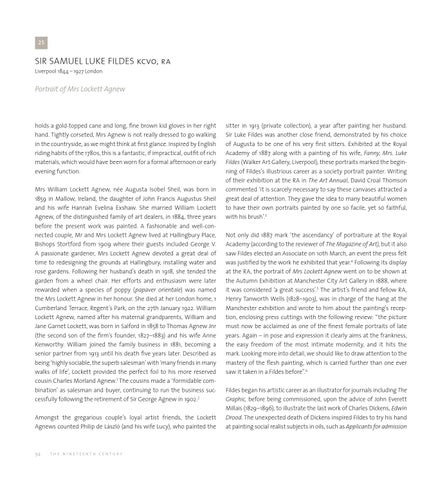CF SIR SAMUEL LUKE FILDES kcvo, ra Liverpool 1844 – 1927 London
Portrait of Mrs Lockett Agnew
holds a gold-topped cane and long, fine brown kid gloves in her right hand. Tightly corseted, Mrs Agnew is not really dressed to go walking in the countryside, as we might think at first glance. Inspired by English riding habits of the 1780s, this is a fantastic, if impractical, outfit of rich materials, which would have been worn for a formal afternoon or early evening function. Mrs William Lockett Agnew, née Augusta Isobel Sheil, was born in 1859 in Mallow, Ireland, the daughter of John Francis Augustus Sheil and his wife Hannah Evelina Exshaw. She married William Lockett Agnew, of the distinguished family of art dealers, in 1884, three years before the present work was painted. A fashionable and well-connected couple, Mr and Mrs Lockett Agnew lived at Hallingbury Place, Bishops Stortford from 1909 where their guests included George V. A passionate gardener, Mrs Lockett Agnew devoted a great deal of time to redesigning the grounds at Hallingbury, installing water and rose gardens. Following her husband’s death in 1918, she tended the garden from a wheel chair. Her efforts and enthusiasm were later rewarded when a species of poppy (papaver orientale) was named the Mrs Lockett Agnew in her honour. She died at her London home, 1 Cumberland Terrace, Regent’s Park, on the 27th January 1922. William Lockett Agnew, named after his maternal grandparents, William and Jane Garnet Lockett, was born in Salford in 1858 to Thomas Agnew Jnr (the second son of the firm’s founder, 1827–1883) and his wife Anne Kenworthy. William joined the family business in 1881, becoming a senior partner from 1913 until his death five years later. Described as being ‘highly sociable, the superb salesman’ with ‘many friends in many walks of life’, Lockett provided the perfect foil to his more reserved cousin Charles Morland Agnew.1 The cousins made a ‘formidable combination’ as salesman and buyer, continuing to run the business successfully following the retirement of Sir George Agnew in 1902.2 Amongst the gregarious couple’s loyal artist friends, the Lockett Agnews counted Philip de László (and his wife Lucy), who painted the
94
sitter in 1913 (private collection), a year after painting her husband. Sir Luke Fildes was another close friend, demonstrated by his choice of Augusta to be one of his very first sitters. Exhibited at the Royal Academy of 1887 along with a painting of his wife, Fanny, Mrs. Luke Fildes (Walker Art Gallery, Liverpool), these portraits marked the beginning of Fildes’s illustrious career as a society portrait painter. Writing of their exhibition at the RA in The Art Annual, David Croal Thomson commented ‘it is scarcely necessary to say these canvases attracted a great deal of attention. They gave the idea to many beautiful women to have their own portraits painted by one so facile, yet so faithful, with his brush’.3 Not only did 1887 mark ‘the ascendancy’ of portraiture at the Royal Academy (according to the reviewer of The Magazine of Art), but it also saw Fildes elected an Associate on 10th March, an event the press felt was justified by the work he exhibited that year.4 Following its display at the RA, the portrait of Mrs Lockett Agnew went on to be shown at the Autumn Exhibition at Manchester City Art Gallery in 1888, where it was considered ‘a great success’.5 The artist’s friend and fellow RA, Henry Tanworth Wells (1828–1903), was in charge of the hang at the Manchester exhibition and wrote to him about the painting’s reception, enclosing press cuttings with the following review: “the picture must now be acclaimed as one of the finest female portraits of late years. Again – in pose and expression it clearly aims at the frankness, the easy freedom of the most intimate modernity, and it hits the mark. Looking more into detail, we should like to draw attention to the mastery of the flesh painting, which is carried further than one ever saw it taken in a Fildes before”.6 Fildes began his artistic career as an illustrator for journals including The Graphic, before being commissioned, upon the advice of John Everett Millais (1829–1896), to illustrate the last work of Charles Dickens, Edwin Drood. The unexpected death of Dickens inspired Fildes to try his hand at painting social realist subjects in oils, such as Applicants for admission
the nineteenth century
130517 Portraiture.indd 94
17/05/2013 17:56
